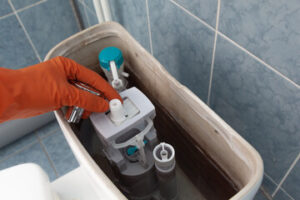Although toilets may seem simple, they are actually a complicated fixture. If your toilet starts to drip water, the tank may not fill properly, or the water is too weak to flush, you may have a problem. While most toilet problems can be fixed with some basic tools and some DIY knowledge, you should consider a professional plumber when a problem is more complicated. Here are some basic steps you can follow to solve common toilet problems. These steps will help you maintain the health of your toilet and prevent any further damage.

First, turn off the water supply. Inspect the tank for leaks and other damage. The tank connects to the bowl below and to the supply line coming from the wall. If you are dealing with several fixtures, you should turn off the water supply to minimize the risk of water damage. If the problem is confined to a single tank, you should call a plumber. If multiple leaks are found, this is usually a sign of a larger plumbing problem.
Another cause of leakage is the wax ring or the flange. Make sure that the flange is securely installed and not loose. If there is a gap between the flange and the bottom of the toilet, water will start to leak. When the flange is not tight, the toilet will rock, which is unsanitary. Also, a wax-free ring will help you avoid this mess.
After you have identified the problem, use a Toilet Repair Guide to perform a simple toilet repair. It will provide step-by-step photos and video instructions for rebuilding the toilet tank. Afterward, you can use a flathead screwdriver to pry off the plastic caps covering the bolts on the base of the toilet. Next, take a bucket and a sponge to soak up any water. When you’ve done all this, place the bowl on the old carpeting.
If you have an in-house handyman, he may be able to fix the problem quickly and easily. If you’re not handy, he or she may be able to find the problem and solve it for you. You’ll want to hire a handyman if you don’t feel confident enough to try the repairs yourself. If you’re worried about the plumbing, you can ask him to check the tank for leaks.
If the tank ball isn’t the problem, your toilet’s ballcock assembly is probably the culprit. If this is the case, make sure you shut off the water to the toilet. If the problem persists, you may need to check the lift wire or the guide to fix the issue. If the latter is the case, you’ll need to replace the valve plunger. A new lift wire can also prevent the toilet from running continuously.
Clogged toilets are another common problem. They build up water each time you flush. Common causes of clogs include too much toilet paper or a child flushing toys. A plumber can unclog the toilet by using a plunger, removing the fixture, and inspecting the pipes. Once the tank is clear, the plumber can fix the problem. However, if the problem is affecting the whole toilet, you should consult a professional plumber to make sure your plumbing is still in good shape.
Changing a flange costs about $60 to $200, depending on the complexity. The flange is a key part of the toilet, keeping the fixture in place on the floor and connecting it to the drain pipe. A broken flange makes the toilet inoperable and may cause water leaks. In such a case, you’ll need to call a professional handyman. You’ll need to remove the toilet to access the flange, which will increase the cost.
A seat replacement is another simple way to fix a leaking toilet. The cost of the new seat is usually between $60 and $150. Seats are one of the most important parts of a toilet since they are the part that you sit on when you use the fixture. Different materials, styles, and colors make a seat different from the rest of the fixture. Changing a seat may be the most cost-effective option. If you are interested in upgrading the look and feel of your toilet, a seat replacement can be a great way to make it more comfortable.